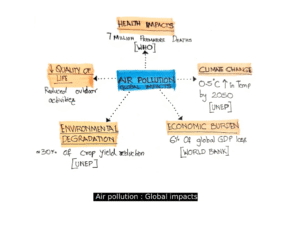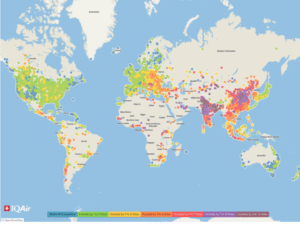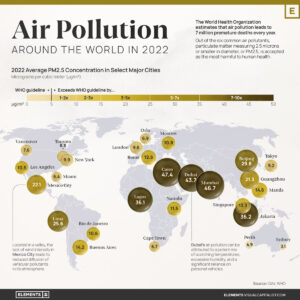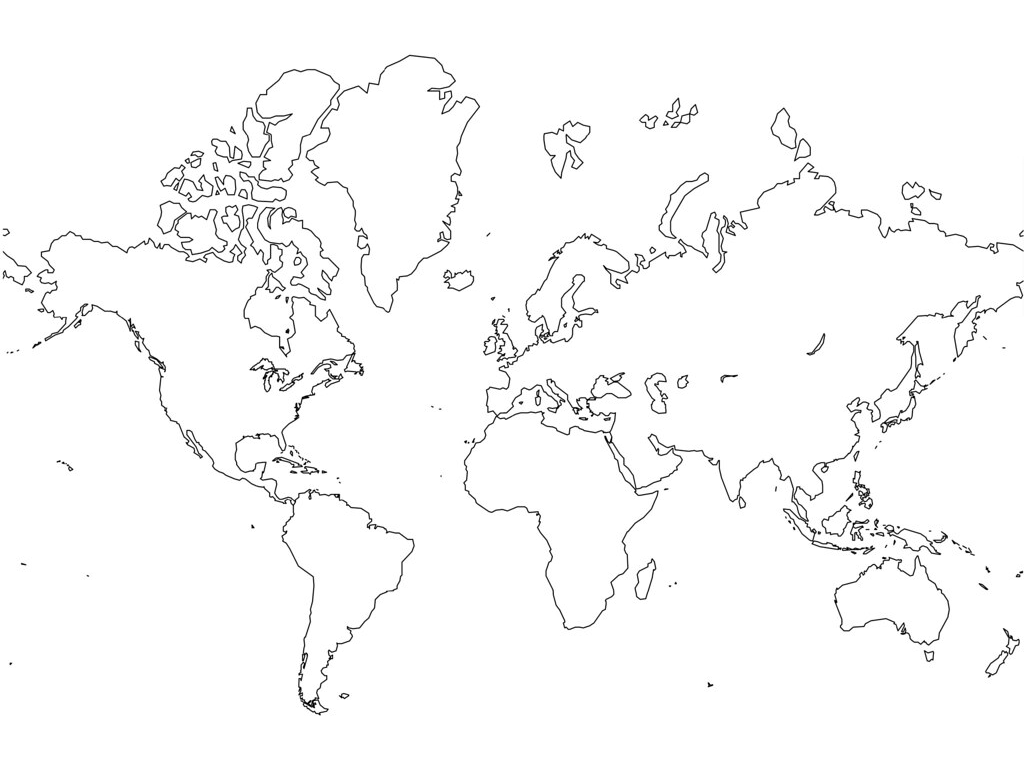Having understood the main reasons for the Haze in Mumbai as Air Pollution (while its humid weather and the coastline support the formation of the Haze), it is safe to say that Air Pollution and, in a broader sense, Air Quality, is a global concern. While I work on projects on improving Air Quality at my host organisation, I get an understanding on Air Quality improvement plans at city, state and national level, which brings me to question the broader goal as a planet? How are we looking at improving Air Quality together as a union?
At a global level, deterioration of air quality due to air pollution has major impacts at large scales; It has major health impacts, impact on climate which leads to climate change, it has a significant impact on the economy, it causes environmental degradation and it also affects the Quality of Life (QoL). Considering these enormous impacts, let us try and understand air quality in a global context. How are we responding to air quality deterioration?

The global stance on Air Quality acknowledges air pollution as a major environmental concern and requires immediate traction. Access to healthy air has been declared as a universal human right and 99% of the global population lives in areas that do not meet recommended air quality guideline levels.
Air quality is addressed globally through policies, agreements, and collaborative initiatives. Most countries don’t create policies in isolation, they combine guidelines set by the World Health Organisation (WHO), national research, and international agreements to shape their air quality policies. We can simplify this as follows:
Global Guidelines on Air Quality
While several international organisations and regulatory bodies establish air quality standards to guide countries in maintaining safe environmental and health conditions, the WHO acts as a global benchmark which sets guidelines on Air Quality, recommending the limits of pollutant concentration in the air. These guidelines are not legally binding and most countries use them as a reference and set their own limits based on their local conditions.
Global Agreements on Air Quality
Several global agreements address Air Quality by setting pollution reduction targets and promoting international cooperation like; The Paris Agreement, which aims to reduce greenhouse gas emissions, indirectly improving air quality and this has been signed by 195 countries, including the USA, China, India, EU nations, Brazil, and Canada. The Geneva Convention, which works towards reducing cross-border air pollution, involves 51 countries, mainly from Europe, North America, and Central Asia.
National efforts on Air Quality
At national levels, countries take individual efforts to curb and address air pollution like;
the Clean Air Act incorporated by the United States which regulates industrial, vehicle, and power plant emissions, the EU Air Quality Directives which sets legally binding limits for pollutants in European Union nations, the Air Pollution Control Action Plan by China which focuses on reducing coal dependency, vehicle emissions, and industrial pollution, the National Clean Air Programme (NCAP) by India which targets 40% reduction in Particulate Matter (PM) concentration by 2026.
Global level monitoring of Air Quality
There are monitoring efforts in Air Quality at the global level, such as NASA & ESA Satellites which track global air pollution from space, IQAir & UNEP which provide global Air Quality reports with real-time pollution data made available to the public and National Air Monitoring Networks, where countries operate ground-based sensors to measure air pollutants.

Source: IQAir
Based on these monitoring efforts and recent data, the countries most affected by air pollution, ranked by average annual PM concentration, include Chad, which is ranked first, followed by Bangladesh, Pakistan, and the Democratic Republic of the Congo. India also ranks high, with urban areas experiencing particularly severe air quality issues. These nations face consistently high levels of air pollution, highlighting the ongoing global challenge of maintaining clean air and addressing environmental health risks.

Source: Mapped: Air Pollution Levels Around the World in 2022 – Visual Capitalist
“Air pollution remains a critical threat to both human health and environmental stability, yet vast populations remain unaware of their exposure levels,” – Frank Hammes, Global CEO of IQAir.
1. United Nations. The UN General Assembly declares access to clean and healthy environment a universal human right. Published July 28, 2022. 2. World Health Organization. (October 24, 2024)


